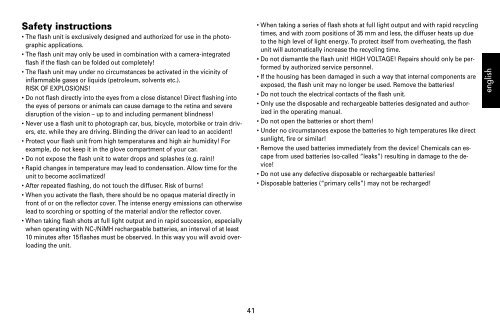You also want an ePaper? Increase the reach of your titles
YUMPU automatically turns print PDFs into web optimized ePapers that Google loves.
Safety instructions<br />
• The flash unit is exclusively designed and authorized for use in the photographic<br />
applications.<br />
• The flash unit may only be used in combination with a camera-integrated<br />
flash if the flash can be folded out completely!<br />
• The flash unit may under no circumstances be activated in the vicinity of<br />
inflammable gases or liquids (petroleum, solvents etc.).<br />
RISK OF EXPLOSIONS!<br />
• Do not flash directly into the eyes from a close distance! Direct flashing into<br />
the eyes of persons or animals can cause damage to the retina and severe<br />
disruption of the vision – up to and including permanent blindness!<br />
• Never use a flash unit to photograph car, bus, bicycle, motorbike or train drivers,<br />
etc. while they are driving. Blinding the driver can lead to an accident!<br />
• Protect your flash unit from high temperatures and high air humidity! For<br />
example, do not keep it in the glove compartment of your car.<br />
• Do not expose the flash unit to water drops and splashes (e.g. rain)!<br />
• Rapid changes in temperature may lead to condensation. Allow time for the<br />
unit to become acclimatized!<br />
• After repeated flashing, do not touch the diffuser. Risk of burns!<br />
• When you activate the flash, there should be no opaque material directly in<br />
front of or on the reflector cover. The intense energy emissions can otherwise<br />
lead to scorching or spotting of the material and/or the reflector cover.<br />
• When taking flash shots at full light output and in rapid succession, especially<br />
when operating with NC-/NiMH rechargeable batteries, an interval of at least<br />
10 minutes after 15 flashes must be observed. In this way you will avoid overloading<br />
the unit.<br />
41<br />
• When taking a series of flash shots at full light output and with rapid recycling<br />
times, and with zoom positions of 35 mm and less, the diffuser heats up due<br />
to the high level of light energy. To protect itself from overheating, the flash<br />
unit will automatically increase the recycling time.<br />
• Do not dismantle the flash unit! HIGH VOLT<strong>AG</strong>E! Repairs should only be performed<br />
by authorized service personnel.<br />
• If the housing has been damaged in such a way that internal components are<br />
exposed, the flash unit may no longer be used. Remove the batteries!<br />
• Do not touch the electrical contacts of the flash unit.<br />
• Only use the disposable and rechargeable batteries designated and authorized<br />
in the operating manual.<br />
• Do not open the batteries or short them!<br />
• Under no circumstances expose the batteries to high temperatures like direct<br />
sunlight, fire or similar!<br />
• Remove the used batteries immediately from the device! Chemicals can escape<br />
from used batteries (so-called “leaks”) resulting in damage to the device!<br />
• Do not use any defective disposable or rechargeable batteries!<br />
• Disposable batteries (“primary cells”) may not be recharged!<br />
english


